Using wavelet transforms and machine learning to predict droughts
Earlier this month, the National Oceanic and Atmospheric Administration (NOAA) released its report State of the Climate in 2015, which showed extreme drought occurred on every continent in the past year. It also reported the amount of land considered to be under the effects of either severe or extreme drought increased from 8% in 2014 to 14% in 2015.

2015 drought map and histogram. Image credit: NOAA Climate.gov. Adapted from the State of the Climate in 2015.
Drought can have devastating effects on the environment and society. It has been linked to economic, environmental, and social impacts such as crop loss, natural habitat destruction, and poverty. According to CNBC, the total economic loss last year in California alone was approximately $2.7 billion, and drought resulted in 21,000 jobs lost statewide. In extreme cases, drought can cause famine and warfare.
What if there was a way to accurately predict drought?
While drought conditions have occurred year after year for decades, the severity, duration, and location have varied. At this point, eliminating drought is not feasible. But if we could accurately forecast drought, could we lessen its effects?
- Farmers could be warned before planting season. They could limit the amount of seed planted to an amount sustainable with existing irrigation or switch the planting to a more drought-tolerant crop.
- Wildfire prevention activities could focus on areas predicted to suffer from drought. Resources such as equipment and personnel could be aligned with likely problem areas in advance, and preemptive measures such as prescribed burns or fire breaks could be put in place.
- Local governments could address water resource management before the start of the drought to lessen the impact.
Using machine learning and wavelet transforms to accurately predict drought
Climatologists have been developing drought prediction models for just this purpose. Many have used machine learning techniques such as artificial neural networks (ANN) and support vector regression (SVR) to train their models. In addition to machine learning, some researchers are exploring adding wavelet transforms to their models. Hybrid approaches have included wavelet-ANN (WANN) and wavelet-SVR (WSVR) models.
In a study recently published in Atmospheric Research, Coupling machine learning methods with wavelet transforms and the bootstrap and boosting ensemble approaches for drought prediction, researchers from Carleton University and McGill University coupled wavelet transforms and ANN and SVR models with bootstrap and boosting ensembles for the purposes of drought predictions:
“This study predicted the Standardized Precipitation Index (SPI) using a combination of the bootstrap and boosting techniques with ANN and SVR models. In addition, wavelet analysis was used to preprocess the SPI data series.”
In this study:
- All ANN models in the study were created using MATLAB. The models were partitioned using the cross-validation technique where 80% of the data was used to train the model, 10% was used to validate the model, and the final 10% was used to test the network.
- The SVR models were created using OnlineSVR software.
- Wavelets were used in the pre-processing step to denoise the original time series signals using Discrete Wavelet Transform to improve the prediction accuracy of the new hybrid WANN and WSVR models.
- The bootstrap technique is used for statistical interpretation. It estimates statistical characteristics such as bias, variance, distribution functions, and confidence intervals and can be combined with machine learning techniques.
- The boosting ensemble models in this study were developed in MATLAB. The boost algorithm has a self-terminating function in MATLAB. It causes the model to stop training when the optimal number of ensembles is selected. The researchers used two types of boosting-ensemble models, boosting-ANN and boosting-SVR models. Both of these model types were trained in the same manner as traditional ANN and SVR models, with the exception that the original SPI time series was boosted using the ‘fitensemble’ function in MATLAB.
The study showed that wavelet analysis could improve the accuracy of the different machine learning techniques considered:
“The ability of wavelets to de-noise time series data was shown to be helpful in predicting the SPI. The use of ensembles, in the form of boosting and bootstrap models, allowed the models to be more robust.”
It also showed that machine learning could be utilized to accurately calculate the potential for a given area to experience drought.
Check out our wavelet tech talk or machine learning videos for more information.









Comments
To leave a comment, please click here to sign in to your MathWorks Account or create a new one.